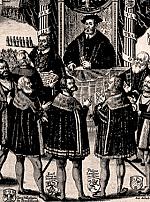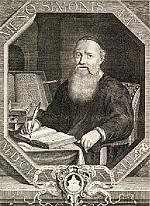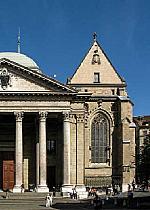The Gospel Truth
Luther wrote six hymns to be sung as part of his instruction in the catechism, which was his simple but powerful explanation of the Ten Commandments, the Apostles’ Creed, the Lord’s Prayer, Baptism, and the Lord’s Supper.
When he preached on the Lord’s Prayer, for example, the congregation also sang the hymn he wrote that paraphrased and expanded each of the prayer’s petitions. Luther’s explanation of the final “amen” echoed his instruction from the Small Catechism about what the believer should do after saying a final evening prayer (“Then go to sleep at once and in good cheer”):
Amen! that is, let this come true!Strengthen our faith ever anew,
That we may never be in doubt
Of that we here have prayed about.
In thy name, trusting in thy word,
We blithely say Amen, O Lord.
The hymn for the Apostles’ Creed features a memorable versification of the second part concerning Christ and his work:
He was made our elder brother
That the lost might find salvation;
Slain on the cross by wicked men
And raised to life again.
The hymn to accompany instruction on baptism, which was the last of these hymns that Luther composed, first tells the story of Jesus’ own baptism:
To Jordan when our Lord had gone,
His Father’s pleasure willing,
He took his baptism of St. John,
His work and task fulfilling.
Then it turns to the contemporary significance of the rite and offers a full summary, not only of Luther’s theology, but of the theology that drove J. S. Bach as well:
The eye but water doth behold,
As from man’s hand it floweth;
But inward faith the power untold
Of Jesus Christ’s blood knoweth.
Faith sees therein a red flood roll,
With Christ’s blood dyed and blended,
Which hurts of all kinds maketh whole,
From Adam here descended,
And by ourselves brought on us.
By Mark Noll
[Christian History originally published this article in Christian History Issue #95 in 2007]
Next articles
Christian History Timeline: The Gospel According to Bach
The dates of Bach and important events preceding and following his life.
Paul Westermeyer and the editorsFrom Luther to the Lutherans
How a dynamic reform movement became a territorial church
David M. WhitfordFrom turmoil to peace
How Menno Simons and Pilgram Marpeck guided Anabaptists through troubled times
Mary S. SprungerAnother accidental revolutionary
The rise of the Reformed tradition in France—and its most famous son
Jon Balserak





